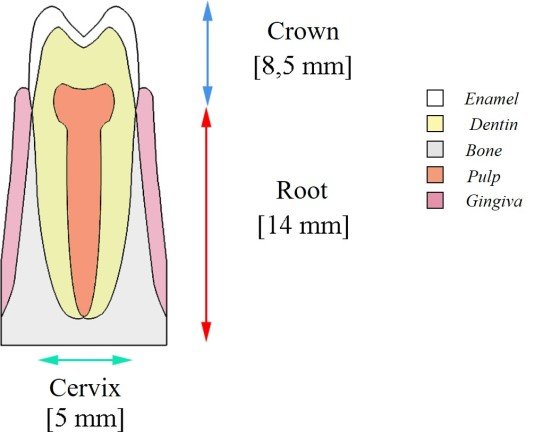If you’re like most people, you probably have bicuspid teeth and don’t even know it! Bicuspid teeth, also known as premolars, are located in the back of your mouth, between your molars and canines, and are responsible for chewing food. In this article, we will provide a breakdown of bicuspid teeth – what they are, where they’re located, and what their purpose is. We’ll also provide information on how to care for them properly!
What are the Bicuspid Teeth?

The bicuspid teeth, or premolars, are the teeth located after your canines and in front of your molars. There are eight bicuspid teeth in total – four on the top and four on the bottom.
If you count back from your central incisors (the very center tooth), the bicuspid teeth are the fourth and fifth teeth in the mouth. In the picture above the bicuspid teeth are highlighted in yellow. It is important to note that baby teeth, also known as primary teeth, do not have bicuspids.
The bicuspid teeth have two cusps, or bumps, on their chewing surface. That is why they are named bicuspid after the Latin roots “bi”, meaning two, and “cuspid” meaning a point or a peak.
What are Bicuspid Teeth Used For?
The bicuspid teeth have a very interesting structure, halfway between the molars and canines. This makes them extremely versatile in their use.
The canine teeth are used for tearing food, while the molars are used for grinding food. The bicuspid teeth act as a transition between these two teeth and can do both of these things!
Anatomy of Bicuspid Teeth

Like all teeth, bicuspid teeth have two main parts: the crown and the root.
- Crown: The crown is the part of the tooth that is visible in the mouth. As discussed previously, bicuspid teeth have two cusps or bumps on their chewing surface.
- Root: The root is the part of the tooth that is embedded in the jawbone. Bicuspid teeth typically have one root, while molars have two or three roots.
Each tooth is composed of three main parts: enamel, dentin, and pulp.
- Enamel: The enamel is the hardest part of the tooth and is what gives the tooth its white color. It is also the hardest substance in the human body. Its function is to protect the tooth from chewing and biting forces.
- Dentin: Dentin is a hard, yellowish material that makes up the majority of the tooth. Its function is to support the enamel and protect the pulp from bacteria.
- Pulp: The pulp is the innermost part of the tooth that contains blood vessels and nerves. Its function is to provide nutrients and sensation to the tooth.
How to Keep Your Teeth Clean
The bicuspid teeth, just like every other tooth, are vital to proper oral health and it is important to take care of them! Not cleaning them properly can lead to cavities, gum disease, and eventually tooth loss.
Here are a few tips on how to clean bicuspid teeth:
- Brush your teeth twice a day with fluoride toothpaste: Flouride is a mineral that helps to remineralize your teeth and prevent cavities. Be sure to brush all teeth surfaces, including near the gum line, and pay attention to your back teeth. The most frequently missed locations.
- Floss ATLEAST every day (But recommended twice a day): Flossing removes plaque and germs from between your teeth, helping to prevent cavities between teeth. Be sure to hug the curve of each tooth as you floss and go slightly under the gumline.
- Visit the dentist every six months: Regular dental visits are important in order to catch any problems early and to keep your teeth healthy! They can also provide cleanings that are more thorough than what you can do at home.
Disclaimer
The contents of this website, such as text, graphics, images, and other material are for informational purposes only and are not intended to be substituted for professional medical advice, diagnosis, or treatment. Nothing on this website constitutes the practice of medicine, law or any other regulated profession.
No two mouths are the same, and each oral situation is unique. As such, it isn’t possible to give comprehensive advice or diagnose oral conditions based on articles alone. The best way to ensure you’re getting the best dental care possible is to visit a dentist in person for an examination and consultation.
SAVE TIME AND MONEY AT ANY DENTIST

Less dental work is healthier for you. Learn what you can do to minimize the cost of dental procedures and avoid the dentist altogether!


I had my second bicuspid tooth on the bottom left jaw, 3 days later I had ringing in both of my ears. It’s been a month and my ears still ring. Could removal of my tooth be the cause